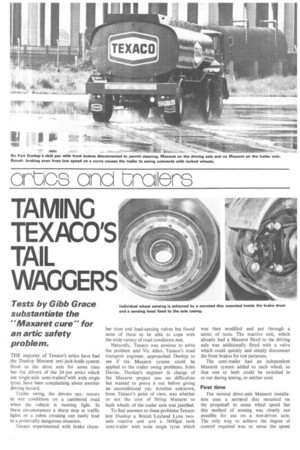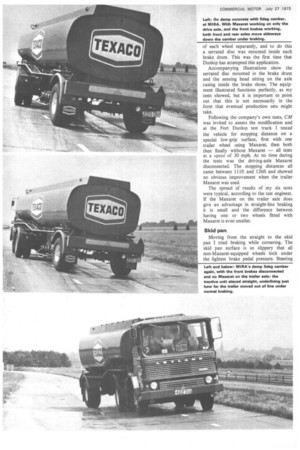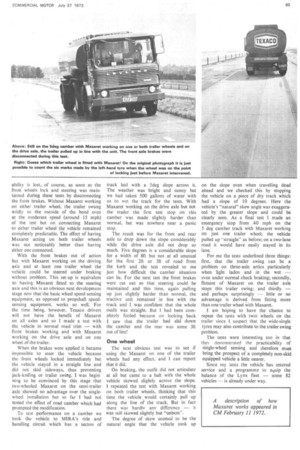TAMING TEXACO'S TAIL WAGGERS
Page 63

Page 64

Page 65

If you've noticed an error in this article please click here to report it so we can fix it.
Tests by Gibb Grace substantiate the "Maxaret cure" for an artic safety problem.
THE majority of Texaco's artics have had the Dunlop Max aret anti-jack-knife system fitted to the drive axle for some time but the drivers of the 24-ton artics which use single-axle semi-trailerewith wide single tyres. have been complaining about another driving hazard.
Trailer swing, the drivers say, occurs in wet conditions on a cambered road when the vehicle is running light. In these circumstances a sharp stop at traffic lights or a zebra crossing can easily lead to a potentially dangerous situation.
Texaco experimented with brake charn
ber sizes and load-sensing valves but found none of these to be able to cope with the wide variety of road conditions met.
Naturally, Texaco was anxious to solve the problem and Vic Allen, Texaco's road transport engineer, approached Dunlop to see if the Maxaret system could be applied to the trailer swing problems. John Davies, Dunlop's engineer in charge of the Maxaret project saw no difficulties but wanted to prove it out before giving an unconditional ye. Another unknown, from Texaco's point of view, was whether or not the cost of fitting Maxaret to both wheels of the trailer axle was justified.
To find answers to these problems Texaco lent Dunlop a British Leyland Lynx twoaxle tractive unit and a 3600ga1 tank semi-trailer with wide single tyres which was then modified and put through a series of tests. The tractive unit, which already had a Maxaret fitted to the driving axle was additionally fitted with a valve which could quickly and simply disconnect the front brakes for test purposes.
The semi-trailer had an independent Maxaret system added to each wheel, so that one or both could be switched in or out during testing, or neither used.
First time The normal drive-axle Maxaret installation uses a serrated disc mounted on the propshaft to sense wheel speed but this method of sensing was clearly not possible for use on a non-driven axle. The only way to achieve the degree of control required was to sense the speed of each wheel separately, and to do this a serrated disc was mounted inside each brake drum. This was the first time that Dunlop has attempted this application.
Accompanying illustrations show the serrated disc mounted in the brake drum and the sensing head sitting on the axle casing inside the brake shoes. The equipment illustrated functions perfectly, as my tests showed, but it is important to point out that this is not necessarily in the form that eventual production sets might take.
Following the company's own tests, CM was invited to assess the modification and at the Fort Dunlop test track I tested the vehicle for stopping distance on a special low-grip surface, first with one trailer wheel using "Maxaret, then both then finally without Maxaret — all tests at a speed of 30 mph. At no time during the tests was the driving-axle Maxaret disconnected. The stopping distances all came between 111ft and 126ft and showed no obvious improvement when the trailer Maxaret was used.
The spread of results of my six tests were typical, according to the test engineer. If the Maxaret on the trailer axle does give an advantage in straight-line braking it is small and the difference between having one or two wheels fitted with Maxaret is even smaller.
Skid pan Moving from the straight to the skid pan I tried braking while cornering. The skid pan surface is so slippery that all non-Maxaret-equipped wheels lock under the lightest brake pedal pressure. Steering ability is lost, of course, as soon as the front wheels lock and steering was maintained during these tests by disconnecting the front brakes. Without Maxaret working on either trailer wheel, the trailer swung wildly to the outside of the bend even at the moderate speed (around 15 mph) of the test but on connecting Maxaret to either trailer wheel the vehicle remained completely predictable. The effect of having Maxaret acting on both trailer wheels was not noticeably better than having either one connected.
With the front brakes out of action but with Maxaret working on the driving axle and at least one trailer wheel the vehicle could be steered under braking without problem. This set-up is equivalent to having Maxaret fitted to the steering axle and this is an obvious next development stage now that the basic wheel speed-sensing equipment, as opposed to propshaft speedsensing equipment, works so well. For the time being, however, Texaco drivers will not have the benefit of Maxaret on all axles and so I made a test with the vehicle in normal road trim — with front brakes working and with Maxaret working on the drive axle and on one wheel of the trailer.
When the brakes were applied it became impossible to steer the vehicle because the front wheels locked immediately but the vehicle stayed in a straight line and did not skid sideways, thus preventing jack-knifing or trailer swing. I was beginning to be convinced by this stage that two-wheeled Maxaret on the semi-trailer axle showed no advantage over the singlewheel installation but so far I had not tested the effect of road camber which had prompted the modification.
To test performance on a camber we took the vehicle to MIRA's ride and handling circuit which has a secton of track laid with a 5deg slope across it. The weather was bright and sunny but we had taken 500 gallons of water with us to wet the track for the tests. With Maxaret working on the drive axle but not the trailer the first test stop on this camber was made slightly harder than normal, but was nowhere near a panic stop.
The result was for the front and rear axle to drop down the slope considerably while the drive axle did not drop so much. Five degrees is a considerable slope for a width of 8ft but not at all unusual for the first 2ft or 3ft of road from the kerb and the test revealed to me just how difficult the camber situation can be. For the next test the front brakes were cut out so that steering could be maintained and this time, again pulling up just slightly harder than normal, the tractive unit remained in line with the track and I was confident that the whole outfit was straight. But I had been completely fooled because on looking back I saw that the trailer had slid down the camber and the rear was some 3ft out of line!
One wheel The next obvious test was to see if using the Maxaret on one of the trailer wheels had any effect, and I can report that it did.
On braking, the outfit did not articulate at all but came to a halt with the whole vehicle skewed slightly across the slope. I repeated the test with Maxaret working on both trailer wheels, thinking that this time the vehicle would certainly pull up along the line of the track. But in fact there was hardly any difference — it was still skewed slightly but "unbent-.
The degree of skew seemed to be the natural angle that the vehicle took up
on the slope even when travelling dead ahead and we checked this by stopping the vehicle on a piece of dry track which had a slope of 10 degrees. Here the vehicle's "natural" skew angle was exaggerated by the greater slope and could be clearly seen. As a final test I made an emergency stop from 40 mph on the 5 deg camber track with Maxaret working on just one trailer wheel; the vehicle pulled up -straight" as before; on a two-lane road it would have easily stayed in its lane.
For me the tests underlined three things: first, that the trailer swing can be a problem on three-axle arties particularly when light laden and in the wet — even under normal check braking; secondly, fitment of Maxaret on the trailer axle stops this trailer swing; and thirdly — and perhaps surprisingly — little or no advantage is derived from fitting more than one trailer wheel with Maxaret.
I am hoping to have the chance to repeat the tests with twin wheels on the trailer since I suspect that the wide-single tyres may also contribute to the trailer swing problem.
The tests were interesting too in that the demonstrated the practicability of single-wheel sensing and therefore must bring the prospect of a completely non-skid equipped vehicle a little nearer.
Since my tests the vehicle has entered service and a programme to equip the balance of the Lynx fleet — some 82 vehicles — is already under way.
























































































































































